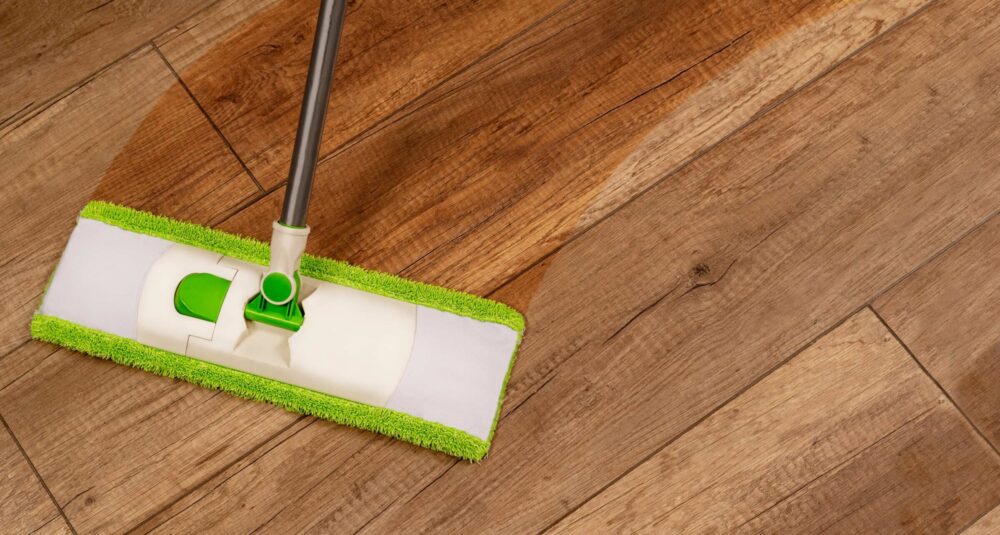You’ve just invested in a brand-new flooring installation. It’s exciting to step into your refreshed space. But keeping that new look takes more than good installation; it requires ongoing care. Maintaining your floors involves simple daily habits like sweeping or vacuuming to remove dirt, immediately cleaning spills with appropriate cleaners, and using proper tools such as microfiber mops and soft brooms. Protect high-traffic areas with rugs and pads, trim pet nails, and avoid dragging heavy furniture. Regular care after flooring installation prevents damage and keeps your floors looking their best.
General Maintenance Practices (Applicable to All Flooring)
Here are some important maintenance practices.
Establish Daily Habits
Simple daily habits go a long way. Make them a part of your routine:
- Dust or sweep daily to collect dust and dirt.
- Remove your footwear at the entrance and reduce wear and tear.
- Use doormats to stop the dirt from getting inside.
These minor steps help you avoid scratches, stains, and dust collection.
Tackle Spills Immediately
- Don’t wait to clean up spills—especially if your floors are prone to staining or warping.
- Use a soft cloth or paper towel to blot (not rub) the spill.
- Gently clean the area with the appropriate cleaner for your floor type.
Use Proper Cleaning Tools & Products
Select those tools to correlate with your type of floor:
- Bare-floor setting: soft-bristle sweeper or vacuum cleaner.
- Use a damp (not soaking) microfiber mop with a neutral pH cleaner.
- Avoid harsh soaps, abrasive detergents, or strong chemicals unless recommended for your flooring type.
- Change or wash mops regularly to prevent having dirty streaks.
Apply Protective Measures
Protect high-traffic zones by adding felt pads under chairs and furniture legs.
- Place area rugs in busy zones to reduce wear.
- Use mats near doors to catch dirt and debris.
- Trim pet nails regularly to prevent floor scratches.
- Avoid wearing shoes indoors to minimize dirt and damage.
- Keep heavy items off newly installed floors for at least 24-72 hours for glue-down or floating floors.
Flooring‑Specific Maintenance
Different floor types have unique care needs. Let’s explore each:
Carpet Installation
- Vacuum frequently, ideally twice a week.
- Blot spills immediately using carpet-safe cleaner.
- Clean deeply by steam or use carpet shampooing every 6–12 months.
- Use high-absorbent rugs in high-traffic zones to catch dirt and moisture.
Hardwood Flooring
- Use a soft-bristle broom or microfiber dust mop daily.
- Monthly polish after the first few months, using a product to your precise finish.
- Damp mop carefully; never soak floors. Wipe moisture away with a dry cloth.
- Refinish when wear becomes visible, typically every 7–10 years or when deep scratches and dullness appear.
- Avoid steam cleaners, harsh soaps, or oils—they can damage finishes.
- Limit sun exposure, as UV rays can discolor the wood.
Laminate Flooring
- Sweep or vacuum using a bare-floor setting to eliminate filth and grit.
- Wipe spills quickly since standing moisture can cause warping.
- Damp mop lightly with a cleaner made for laminate; never flood it.
- Avoid vinegar, wax, or most vegetable oil soaps, which leave residue on exterior finishes.
- Protect from scratches with felt pads and rugs, trim pet nails, and avoid dragging heavy furniture.
LVP (Luxury Vinyl Plank) Flooring
- Sweep or vacuum daily, and mop with warm water and non-abrasive, no-rinse cleaner.
- Avoid rubber-backed mats, waxes, or bleach—they can discolor or damage the floor.
- Clean spills quickly—LVP is waterproof, but staining can occur if left too long.
- Lift heavy objects instead of dragging.
- Use sliders and place rugs in sun-exposed zones to prevent fading.
Epoxy Flooring
- Dust mop and sweep daily to remove grit.
- Mop with mild neutral pH cleaner; avoid acidic or alkaline cleaners.
- For stains, apply isopropyl alcohol or a suggested degreaser.
- Avoid abrasive scrub pads.
- Reapply a protective topcoat when the surface shows signs of wear or dullness; often every few years in heavy-use areas.
Resilient Plank
This includes general vinyl sheets and tiles:
- Sweep or vacuum daily, damp-mop weekly with neutral cleaner.
- Avoid steam mops and harsh chemicals.
- Place mats near sinks/kitchens, and avoid rubber.
Concrete Coating
- Sweep or dust mop regularly to remove fine dust.
- Wet mop with a gentle purifier, then dry to prevent slips.
- Reapply sealant every 1–2 years or whilst water no longer beads up.
Sport Flooring
- Use dust mops daily, and damp mop weekly with pH-neutral cleanser.
- Restrict abrasive or wax cleaners.
- Apply a protective floor finish annually if the manufacturer recommends it.
Vinyl Composite Tile (VCT)
- Dust mop using a floor scrubber or mop with a neutral cleaner.
- Reapply a protective floor finish every few months, depending on use.
Carpet Tile
- vacuum weekly, or more often in high-traffic areas.
- Replace individual stained or worn tiles. No need to replace the entire carpet.
- Use a spot cleaner or steam clean occasionally.
Conclusion
Maintaining your floors after installation is simple with consistent daily habits like sweeping, vacuuming, and promptly cleaning spills. Using proper tools, protecting high-traffic areas, and avoiding harsh chemicals helps preserve their condition. Regularly caring for each flooring type — carpet, hardwood, laminate, or vinyl — ensures longevity and beauty. With these easy practices, your floors will stay clean, damage-free, and looking great for years to come.




